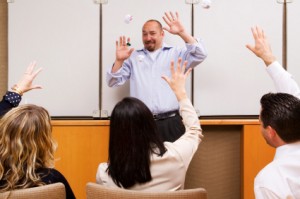 Does your training environment sometimes feel dull (or even dead) as you deliver content? Does the environment itself feel uninspired? Wouldn’t it be great to have a magic wand you could use to inject your training with energy!
Does your training environment sometimes feel dull (or even dead) as you deliver content? Does the environment itself feel uninspired? Wouldn’t it be great to have a magic wand you could use to inject your training with energy!
Such a “magic wand” exists. Called Pair and Share, it is arguably the easiest and most effective training tool you can use. It always increases interaction, whether your class consists of four participants or four hundred. Importantly, Pair and Share also deepens every single participants’ interest and retention.
So…Is Pair and Share Magic?
Once you try it, you may think so. Pair and Share is simply a structured opportunity for your participants to process information in groups of two.
Why Does Pair and Share Work?
This super-easy technique does three important things. It:
- Helps store information in long-term memory
- Allows participants to reflect on content and make it their own
- Increases individual accountability
You can sprinkle Pair and Share several times throughout any training session to increase participation while reinforcing your message.
How to Use Pair and Share
Before or after providing content, guide the participants to form pairs with the person sitting next to them. Instruct them to process a specific, relevant point in the material. Your instructions should force them to work through the topic’s application to their own lives or work. Provide a total amount of time for the exercise—perhaps 30 seconds to one minute.
Select from the following verbs, or use others, when you give instructions.
“Turn to your partner and …
- List
- Discuss
- Fix
- Do
- Figure out
- Fill in
- Share
- Explain (etc.)
Examples:
Please turn to your neighbor and …
- Name five types of safety gloves and what each are used for.
- Define “saturation level”.
- Tell them the most important fact you have learned in the last ten minutes and why.
Believe it or not, this simple technique can determine if your participants remember or forget essential pieces of content. Sprinkle Pair and Shares liberally throughout your training sessions, and watch the classroom come alive!
Want more tips to improve your trainings? Learn how Guila Muir’s Instructional Design Workshop can help you to create powerful, effective training sessions.
Guila Muir , a premiere trainer of trainers, facilitators, and presenters, has helped thousands of professionals improve their training, facilitation, and presentation skills. Find out how she can help transform you from a boring expert to a great trainer!




 by Guila Muir
by Guila Muir With technology forcing constant change in our workplaces, the true “hot commodity” over the next twenty years will be meaningful, face to face contact. However, that contact must be productive. Increasing facilitation skills – of all employees – is key.
With technology forcing constant change in our workplaces, the true “hot commodity” over the next twenty years will be meaningful, face to face contact. However, that contact must be productive. Increasing facilitation skills – of all employees – is key.